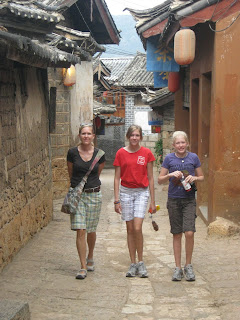 In 1997, Lijiang was hit with a double whammy that proved to be both a blessing and a curse. First, she was hit with a devastating earthquake. This prompted the United Nation’s UNESCO to fast track Lijiang for World Heritage Site status which it duly conferred. The heightened profile brought about by the earthquake and the World Heritage designation combined with the realization that the people of China had almost lost Liajiang brought out the visitors –from both China and overseas- in unprecedented numbers.
In 1997, Lijiang was hit with a double whammy that proved to be both a blessing and a curse. First, she was hit with a devastating earthquake. This prompted the United Nation’s UNESCO to fast track Lijiang for World Heritage Site status which it duly conferred. The heightened profile brought about by the earthquake and the World Heritage designation combined with the realization that the people of China had almost lost Liajiang brought out the visitors –from both China and overseas- in unprecedented numbers.This was a huge boom to the local economy and the efforts of UNESCO have helped to ensure that Lijiang will be well preserved. But the danger is that the city atrophies. Rather than being allowed to change and adapt like every city does, there is and will be tremendous pressure for Lijiang to remain in an indefinite time warp. Granted, it will be beautiful and prosperous, but static none-the-less.
Moreover, success has brought . . . well, success. As the tourists came, more and more buildings became shops, restaurants, and guest houses. Before long, locals couldn’t afford to live locally. Space was too valuable and lucrative to be used for something as extravagant as simply living there. Gentrification had come to Lijiang. Before long, many locals were squeezed out and moved outside of the traditional city boundaries.
On our third morning in Lijiang, I went for an early morning walk while my family slept. I had had my fill of strolling the city proper and looking at batik and jewelry, so I wandered further afield. I got a look behind the velvet curtain. Just outside of town, I stumbled upon a whole shadow village of about a hundred housed in various stages of construction. Fortunately, they were all being built in the tradition style with mostly traditional methods.
(I spent an hour in one house that was under construction watching the carpenters ply their craft. It was engrossing to watch them employ age-old construction techniques. I watch one carpenter do the final assembly on a porch railing without using a single nail.)
If it wasn’t for the wall separating the old town of Lijinag with this new development, the two would flow seamlessly one into the other. In fact, I noticed that one of the new buildings had been built as and was operating as a guest house. I couldn’t help but wonder how long it would be before this area had simple became a part of Old Lijiang and was marketed as such.
Later that day, Julie the girls and I were enjoying our last meal in Lijiang. We had found a little café away from the pressing crowds on the far side of town where Lijiang rises slightly at the base of the neighboring hills. We managed to secure the table by the window (which was just a wooden frame with no glass) that afforded us a view over the cobble-stone lane and a large garden across the street. Beyond the field, we were looking down on the grey roof tiles of the buildings below. The skeptic in me started to emerge. I couldn’t help but wonder if perhaps this “ancient” building we were eating in had been build –or completely rebuilt- in the not so distant past. Then I decided to stop worry about it.
It was what it was.
And it was all quite stunning and invigorating and heartbreakingly beautiful. I decided to revel in the moment with my wife and daughters.
I decided to enjoy the plate of sautéed pumpkin greens sitting in front of me which were undoubtedly quite real and quite authentic.
No comments:
Post a Comment